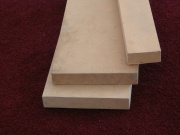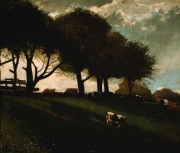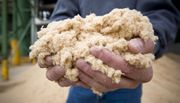Difference between revisions of "Fiberboard"
| Line 57: | Line 57: | ||
* Megan Salas, contributed information, MWG group, 2020. | * Megan Salas, contributed information, MWG group, 2020. | ||
| − | [[Category:Materials database]][[Category:MWG] | + | [[Category:Materials database]][[Category:MWG]]][[Category: Wood]] |
Revision as of 08:23, 10 November 2024
Description
An engineered rigid composite board made of cellulose fibers. First patented in 1858, fiberboards were composed of wood chips or plant fibers, such as Grass, Reed, Straw, Bagasse (Celotex), Jute, Flax, or Hemp. Manufacturers have also recycled waste materials such as Sawdust, Bark, oat hulls, spent hops, newspaper (Homasote®) and peanut shells. The fibers are compressed and bonded with heat and pressure. Many fiberboards are held together by the interlocking fibers and natural adhesives (wet process); other fiberboards have additional adhesive components such as Urea formaldehyde resin, Water glass, Dextrin, Asphalt, Rosin, Paraffin wax, Plaster, and/or Clay. The standard size for fiberboards is 4 x 8 feet. Very dense fiberboard is called hardboard (see also Masonite®). Some commercially available formaldehyde-free fiberboards are Masonite® Presdwood®, Medex, Medite II and Iso-board (Hatchfield 2002). Fiberboards are generally classified as low-density (Celotex, etc.), medium-density (Medex, Medite, etc.), or high-density (Masonite®, Upson Board, Marinite®, Homasote®, etc.).
Synonyms and Related Terms
fibre-board (Br.); fibreboard (Br.); hardboard (Br.); carton-fibre (Fr.); carton fort (Fr.); aglomerado de madeira (Port.); particle board; composition board; engineered wood; wallboard; hardboard; fiber board; high-density fiberboard (HDF); medium-density fiberboard (MDF); low-density fiberboard (LDF)
Brand names: Masonite® [IPI]; Presdwood®; Medex; Medite®; Duron® [IPI]; Upson; Homasote®; Insulite; Beaver Board; Cornell Board; Feltex; Fir-Tex; Nu-Wood; C-X Board; Quartrboard; Celotex;
Applications
- Exhibit - case construction, mountmaking
- Artwork support
Personal Risks
Health risks associated with elevated concentration of volatile organic compounds (VOCs): respiratory irritation, irritability, inability to concentrate, and sleepiness. Health risks associated with exposure to formaldehyde gas: eye and respiratory irritation, respiratory difficulty.
Dust and chemicals released when worked.
Collection Risks
Any wood product may release VOCs (volatile organic compounds) such as aldehydes, terpenes, and acids. The types and quantities of VOCs released depends on wood species, as well as the presence of coatings. Generally, the most VOCs are released when the product is new. Barrier layers (i.e. coatings, or films) can be applied to limit the release of VOCs.
Fiberboards are susceptible to dry rot, fungal growths and termites.
Links to Oddy Test results posted on AIC Wiki Materials Database Pages for individual materials below
- Newmarket MDF tested in 2006
- Newmarket MDF tested in 2006 with polyurethane coating
Working Properties
Dust and chemicals released when worked. Degree of “tear out” (how jagged edge is when sawed) depends on the size of the pieces, with MDF having lower tear out (smoother edge) than Particle board.
Forms and Sizes
The standard size for fiberboards is 4 x 8 feet.
Resources and Citations
- Exhibit Guidelines Technical Notes: Using Composite Panels in Exhibit Case Construction
- Art and Architecture Thesaurus Online, http://www.getty.edu/research/tools/vocabulary/aat/, J. Paul Getty Trust, Los Angeles, 2000.
- Melissa G.D. Baumann, Linda F. Lorenz, Stuart A. Batterman, and Guo-Zheng Zhang, “Aldehyde Emissions from Particleboard and Medium Density Fiberboard Products,” Forest Products Journal 50 (9): 75–82, 2000.
- G.S. Brady, Materials Handbook, McGraw-Hill Book Co., New York, 1971.
- Dictionary of Building Preservation, Ward Bucher, ed., John Wiley & Sons, Inc., New York City, 1996.
- Encyclopedia Britannica, http://www.britannica.com Comment: "wood." (Accessed 14 Mar. 2005).
- C. Gould, K. Konrad, K. Milley, R. Gallagher, "Fiberboard", in Twentieth-Century Building Materials, T. Jester (ed.), McGraw-Hill: New York, 1995. link
- A.Katlan, "Early Wood-Fiber Panels: Masonite, Hardboard and Lower-Density Boards" JAIC 33:301-306, 1994.
- Pam Hatchfield, Pollutants in the Museum Environment, Archetype Press, London, 2002.
- Illinois Department of Public Health, “Formaldehyde,” Environmental Health Fact Sheet, http://www.idph.state.il.us/envhealth/factsheets/formaldehyde.htm (Accessed 25 Sep. 2020).
- Kevin Ann Reinhart, “What Is the Difference Between Particle Board and Medium Density Fiberboard?” SFGate, https://homeguides.sfgate.com/difference-between-particle-board-medium-density-fiberboard-99189.html, (accessed 25 Sep. 2020), 2018.
- Megan Salas, contributed information, MWG group, 2020.]


